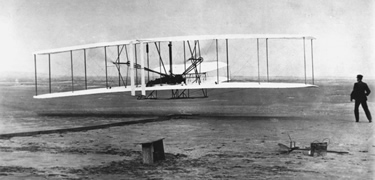

 The Accurate Reloading Forums
The Accurate Reloading Forums  THE ACCURATE RELOADING.COM FORUMS
THE ACCURATE RELOADING.COM FORUMS  Other Topics
Other Topics  Aviation
Aviation  A Celebration of Low Flying
A Celebration of Low FlyingGo  | New  | Find  | Notify  | Tools  | Reply  |  |
| One of Us |
I lay no claim to any of these pictures. I received them in an e-mail and have posted them here in order to share with those who might be interested. Everyone likes to fly low,ya just gotta remember that the record for the lowest flight can only be tied never broken.Just scroll down, check the BUFF flying below the Carrier RANGER's Deck. 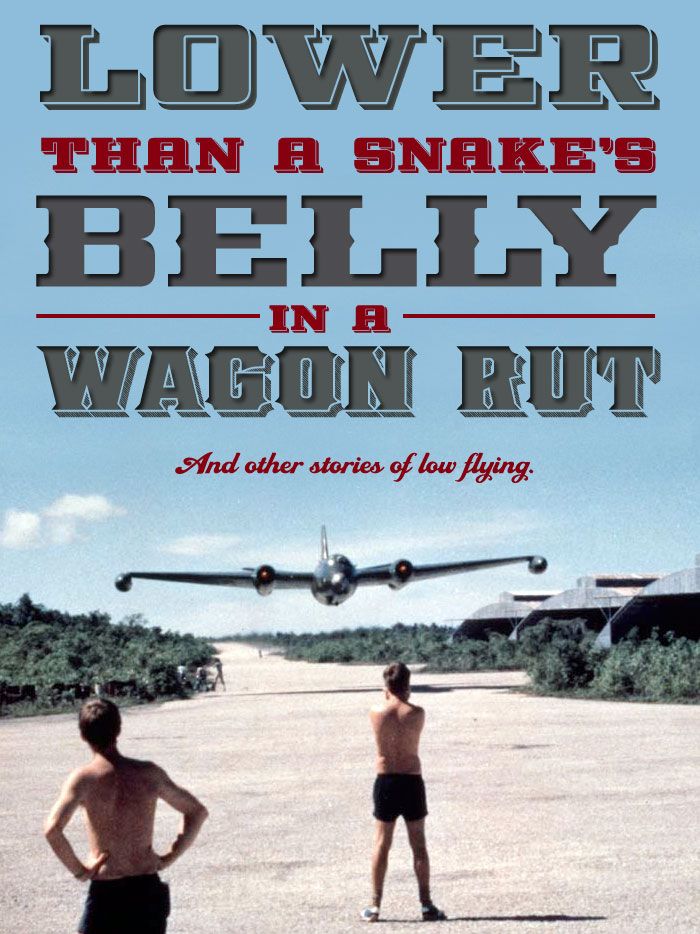 On a particularly hot day, a Royal Australian Air Force English Electric A84 Canberra bomber drops to within 25 feet as thrill-seeking mechanics get ready for the visceral experience of 13,000 lbs of Rolls Royce Avon power full in the face. RAAF Photo 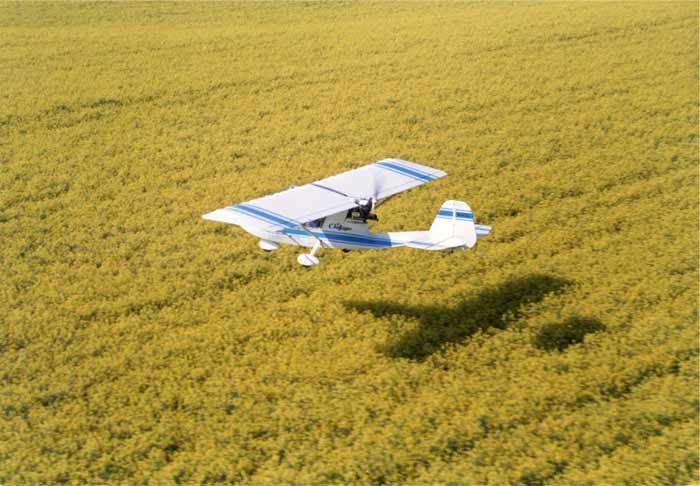 Ian Coristine inspects the alfalfa in his Quad City Challenger ultralight. They loved to fly low in World War Two 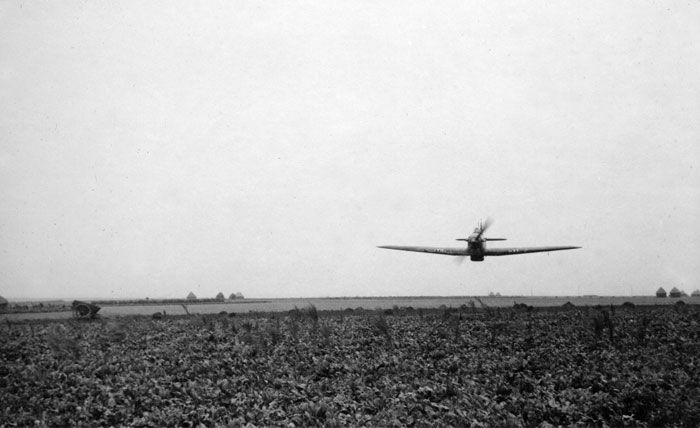 'One more beat-up, me lads.' Flying Officer Cobber Kain, DFC, a New Zealander and the RAF's first ace of the Second World War, is seen here in France performing a low-level flypast. Kain, it has been said, clipped the ground with the propeller throwing grass into the radiator.  A Douglas A-20G Havoc night fighter of the 417th Night Fighter Squadron does a little daylight low flying down in the weeds possibly near the Orlando , Florida base where they were formed. Their first deployment was to Europe where they immediately re-equipped with Bristol Beaufighters. Today, the unit still trains for a night time job, but flying the F-117 Nighthawk or so-called “Stealth Fighter”.  A P-40 flies down the beach at extreme low level, as Marines practice an amphibious landing somewhere in the Pacific. In order to get this photo, the photographer standing on the beach would have had to have his back to the oncoming P-40 trusting that pilot would do a “buzz job” of the beach and not his hair. Photo via Project 914 Archives, Steve Donacik 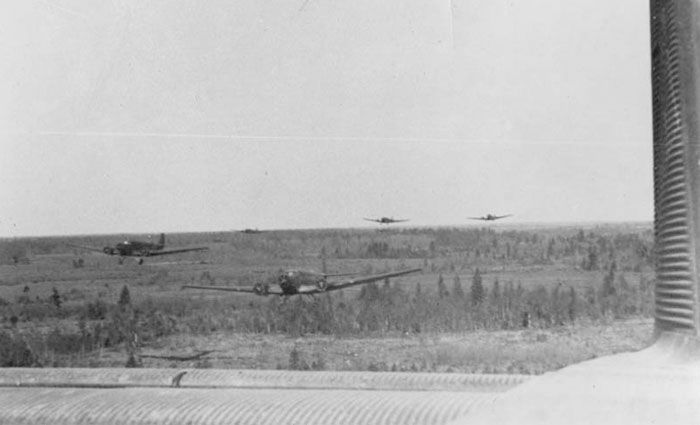 A squadron of Luftwaffe Ju-52 Junkers stream low over the Russian countryside near Demjansk, south of Leningrad . In February to May of 1942, the Germans were surrounded by the Red Army. Supplying the Germans during and after the "Demjansk Pocket”, was the role of the air force. Here, low flying in the slow transports was more a survival tactic than a joyride. Photo via Akira Takaguchi 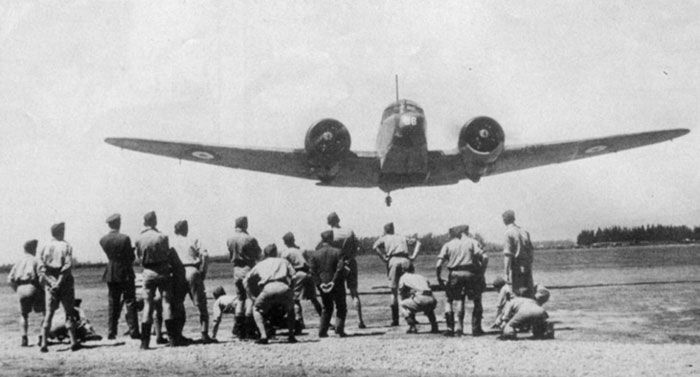 Thought to have been taken in the region of Canterbury, New Zealand in 1944, this shot of an Airspeed Oxford scaring the beejeesus out of half the waiting airmen while the other half remain calm, is a beauty. Photo via Joe Hopwood.  A USAAF P-47 Thunderbolt at extreme low level. Note that the sweep of the camera's pan has bent the buildings in the background 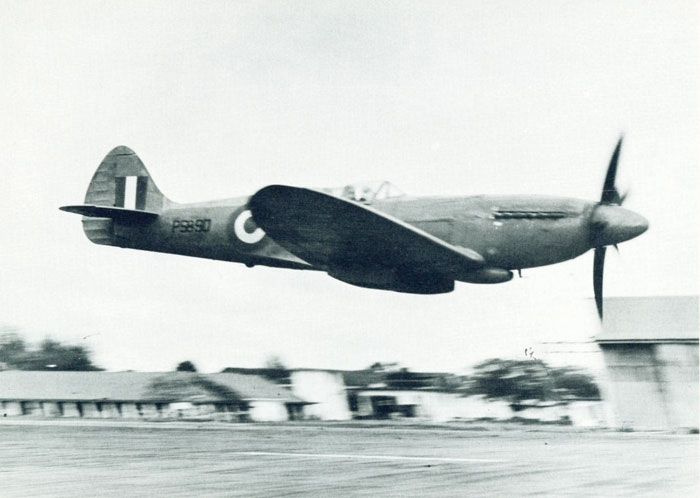 Another shot that has the same effect of bending the buildings in the background (see previous photo). Like our own Spitfire XIV RM873, Griffon-powered PR Spitfire XIX PS890 was sold to the Royal Thai Air Force after the war. She is seen here with 81 Squadron markings and being put through her paces down low at RAF Seletar , Singapore in the summer of 1954 just before her sale. In 1961, PS890 was donated to the Planes Of Fame Museum in California . It was eventually restored and took to the skies again in 2000, albeit with clipped wings and contra-rotating props. It was then purchased by Frenchman Christophe Jacquard and taken to Duxford for the wingtips to be added and a single 5-bladed propeller installed. 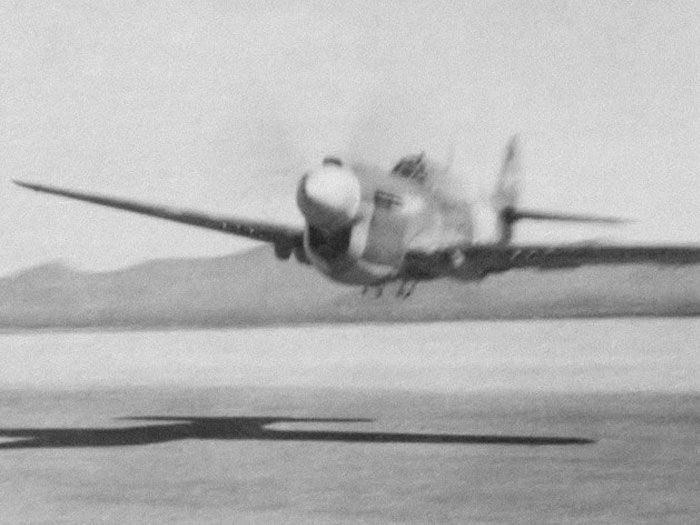 While researching images for our P-40 stories over the past year I came across a massive collection of marvelous wartime photos - mostly of P-40s collected by Steve Reno. This P-40 pilot is risking his life only a little less than the man taking the photo of this ridiculously low level pass across the runway. He’s not much higher than he would be if he was standing on his landing gear! If you trace the invisible line of his prop arc, this skilled numbskull’s tips are only about 4 feet off the ground. Photo via Project 914 Archives, Steve Donacik  For many attacking aircraft, safety lay down low in the wave tops beneath enemy radar coverage. Here, a squadron of Douglas A-20 Boston bombers of the RAF's 88 Squadron head to the target over the North Sea There is often a price to pay.  Some aircraft, such as this Spitfire, reach that fine line between crashing and flying low... about 12 inches too low in the case of this 64 Squadron Spitfire with shattered wooden blades. The aircraft, no doubt shaking badly was nursed back to the safety of an Allied base 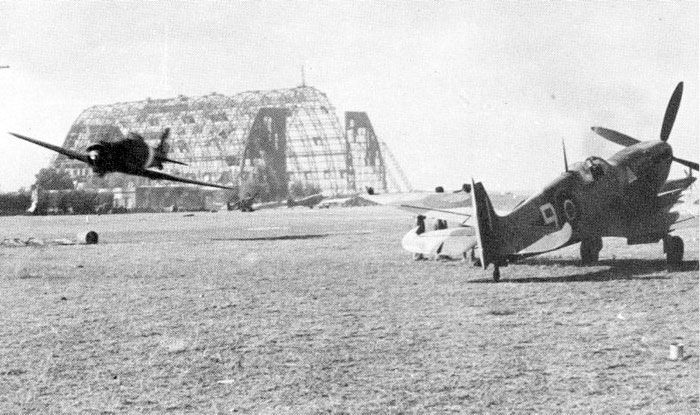 An Allied pilot flying a Macchi 200 buzzing Taranto , Italy . It sadly proved that these kind of stunts aren't without danger as the pilot hit a member of the ground crew and more or less decapitated him. The pilot hadn't noticed a thing and after landing was confronted with a dent in his wing's leading edge, containing skull fragments. 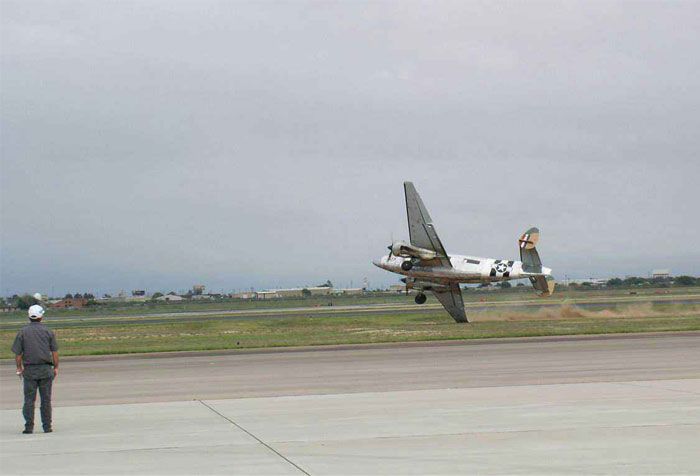 I didn't want to include any shots of an aircraft landing or taking off, just low level flight, But this shot of a Lockheed Harpoon/Ventura dragging its wing in the turnout is interesting enough to include  A P-47 of the 64th Fighter Squadron, while on a mission to Milan , struck the ground during a low level strafing run. Despite the bent props and crushed chin, the pilot nursed the Jug 150 miles home to Grosseto . Photo via Hebb Russell The strange end of Donald Scratch 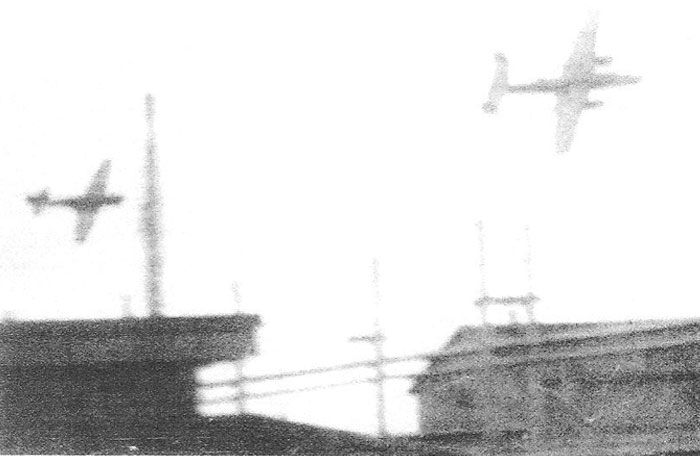 Not an extreme low level shot, but this image of a P-40 chasing a B-25 Mitchell over buildings in the Vancouver area is worth a lengthy explanation. Jack Cook of the Warbird Information Exchange describes the background and the event pictured here: "Sgt. Scratch was born in Saskatchewan , July 7, 1919, and enlisted in the RCAF in Edmonton , as R60973 AC2 on July 20, 1940. He earned his wings as a Sergeant Pilot and flew with that rank for a long time. He flew Liberators from Gander , Newfoundland , as a co-pilot on anti-submarine patrols. Scratch was good at his job and was eventually raised to commissioned rank. As a Flying Officer and with many hours to his credit, Scratch wanted to fly as aircrfaft commander, however, RCAF officials considered that, as he was slight in build, and had suffered ankle injuries in the past, he would not have the strength to control a Liberator in an emergency. Sgt. Scratch wanted more action but was unsuccessful in getting an overseas posting. He became very depressed. One evening, June 19. 1944, in the mess, he entered into a debate about one man being able to take off, fly, and land, a Liberator. Scratch left the mess, went down to the hangar, fired up a Liberator, and took off. He shot up the American base at Argentia, and the base at Gander . When some fighters approached him to order him to land, they found him occupying, and rotating the mid-upper gun turret, with the aircraft on autopilot. The guns were fully armed and operational. When he returned to base he was placed under arrest, later court marshalled, and dishonorably discharged. Mr. Scratch returned to Edmonton , Alberta , and went directly to the RCAF recruiting office where he was accepted back into the RCAF as a Sergeant Pilot. He was posted to No. 5 OTU, Boundary Bay . 5 OTU was training aircrew on Liberators for service against Japan . The British Commonwealth Air Training Plan was winding down and many of the pilots were senior aircrew from Training Command. Again Sgt. Scratch found himself flying second pilot to officers with far less experience than himself. The training started on B-25 Mitchell aircraft and advanced to Liberators. When his experience and flying skills were not recognized, Sgt. Scratch again became frustrated. On December 5, 1944, Sgt. Scratch attempted to take off, unauthorized, in a Liberator, Due to the fact that there was no official flying that night, the field was in darkness and the control tower un-manned, Scratch mistook a roadway for the runway and crashed into a wooden bridge wiping out the undercarriage. Undaunted, he returned to the hangar and signed out a B-25 Mitchell and took off. Scratch flew down to Seattle, Washington, area and beat up the Seattle airport causing many aborted take offs. The Americans sent up fighter aircraft to bring the Mitchell down however, Scratch returned to Canada , disrupting and grounding flights at the Vancouver airport. He then flew around the Hotel Vancouver, well below the roof level and down Granville Street . The following is an eye witness report by Norman Green. “7:00 hrs. December 6, 1944, while it was still dark, I was in the mess hall when it was shaken, and dishes fell to the floor as a result of an aeroplane flying low overhead. The same pass shook WDs out of their bunks. As usual that morning at 8:00 hrs., 1200 airmen and airwomen, all ranks (I among them), formed up on the tarmac in front of the control tower for CO’s inspection. Just as the parade was about to be called to attention a B-25 Mitchell bomber came across the field at zero altitude, and pulled up sharply in a steep climb over the heads of the assembled airmen, just clearing the tower. Within seconds, 1,200 men and women were flat on the ground. The Mitchell then made several 25 ft. passes over the field. Group Captain Bradshaw dismissed the parade and ordered everyone to quarters. Over the next two hours we witnessed an almost unbelievable demonstration of flying, much of it with the B-25’s wings vertical to the ground, below roof top level, defying gravity. We were continually diving into ditches to avoid being hit by a wingtip coming down a station road. He flew it straight and level, vertically with the wing tip only six feet above the ground without losing altitude, defying all logic, and the law of physics.” After an hour of this, three P-40 Kittyhawks from Pat Bay Station arrived on the scene, fully armed, with orders to shoot the B25 down if it left the area of the station. They tried to get on his tail but could not stay with him in his tight turns below rooftop level. After two hours of this, Sgt. Scratch flew over a corner of the field and circled one spot vertically, with the Kittyhawks joining in like may pole dancers. Sgt Scratch then climbed to 2,000 feet and wagged his wings as he crossed the field, boxed in by the fighters. When they were clear of the station, the Kittyhawks signaled Sgt. Scratch to land. He nodded his head, gave them the thumbs down sign, rolled over, pulled back on his controls, and, aiming at an uninhabited spot on Tillbury Island in the Fraser River , dived into it. The shattered red taillight lens was later located dead centre between the points of impact of the engines.” All in all, a remarkable story, but further on in the forum where this account was published, someone named JDK put into workd very eloquently what my thoughts were about this psychopath: “I've always rather liked the saying that 'the superior pilot is one who uses his superior judgment to avoid using his superior skill'. Unless there's bits we don't know, Sgt Scratch was a disgrace with a few remarkable skills. As a military airman, wrecking several aircraft (and worse) simply because he wanted to do another job than allocated in wartime was utterly selfish and short-sighted. Flying skill to the extent of suicide while wasting government equipment and hazarding the lives of your fellow airmen hardly sounds like 'a superb pilot' to me. Makes a good bar tale though. And his ghost walks the corridors to this day...” Film makers love low level flying! 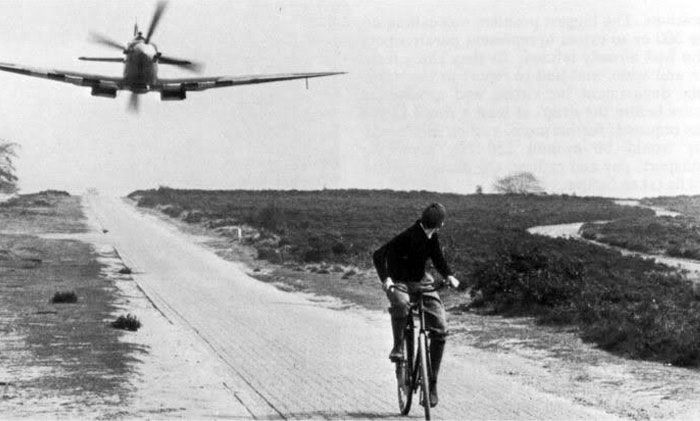 Not actually a scene from the Second World War, but rather the opening scene in the great film A Bridge Too Far. A school boy watches over his shoulder as a recce Spitfire rips up a cobbled road in Normandy . 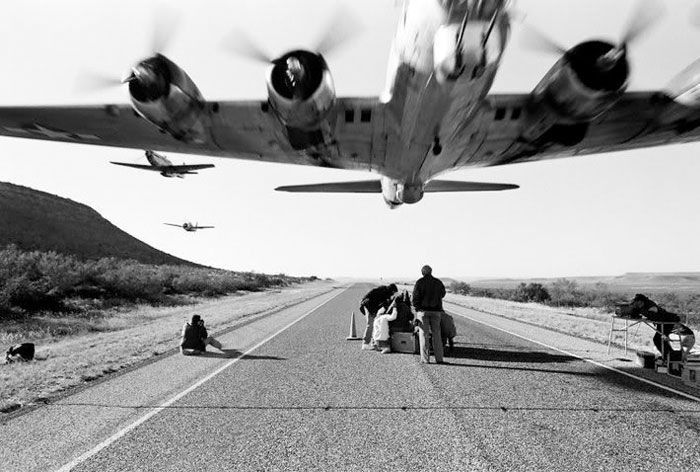 Modern day photographer Murray Mitchell captured this action shot super low B-17 Flying Fortress performing for a film crew and followed by a P-51D Mustang and a P-47 Thunderbolt. Photo via www.murraymitchell.com 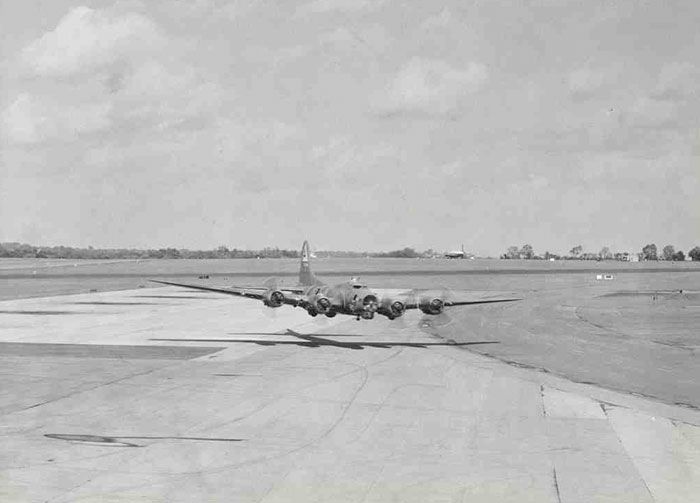 A low fly-past during the filming of the Steve McQueen-Richard Wagner film, The War Lover. Nothing like a good buzz job to get the juices flowing, in this case one of theWar Lover ex PB-1Ws being flown by John Crewdson for a key scene in the movie. Crewdson reportedly flew the airplane solo for the sequence. Photo by David M. Kay Unoccupied desert and sun-baked boredom causes low-levelitis 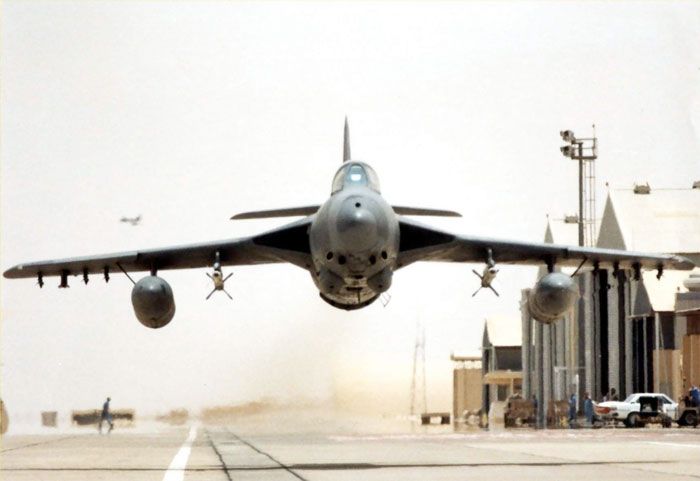 A particularly heart stopping photo of a Hawker Hunter of the Sultan of Oman 's Air Force beating up the base at Salalah. The Sultan employed mercenary Brit pilots to fly Hunters and Strikemasters to help put down the Dhofar rebels in the south. They clearly were bored from time to time! The rebellion ended in 1976, the same year I visited Oman . 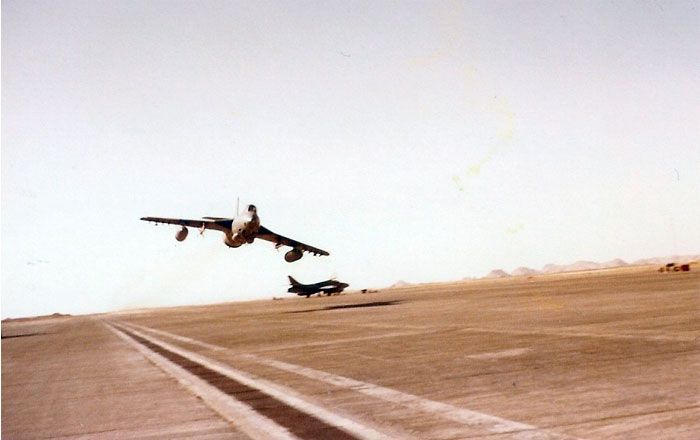 A Hawker Hunter pilot of the Sultan of Oman 's Air Force (SOAF - possibly a former RAF mercenary) shrieks across the ramp on an Omani air base. Photo viaPatricksAviation.com  In the shimmering white heat of an Omani summer day, a Sepecat Jaguar adds superheated jet exhaust to the miserable mix as its pilot shows off for the ground personnel watching from the shade. In 1990, the SOAF was renamed the Royal Air Force of Oman (RAFO). It is not known if this is a SOAF or a RAFO Jag, But forest, buildings and mountains make it more exciting  A Dutch F-16 with burner lit seems to follow the turn in the road. On the ground, Dutch airmen stuff fingers in their ears as he passes over head.  Testosterone fired, speed addicted, and happy-to-still-be-alive youth were the primary source of pilots of the Second World War. At 6 foot, 4 inches, I wouldnt want to be standing up on the runway for this beat-up by a Mosquito. This aircraft had the military serial number RR299 and was built as an unarmed, dual control trainer at Leavesden in 1945. It served in the Middle East until 1949, when it returned to the United Kingdom . It then served with a variety of RAF units, this service being interspersed with periods in storage. The aircraft was retired from the RAF in 1963 and was acquired by Hawker Siddeley Aviation (now British Aerospace) at Chester . The first Permit to Fly was issued on 9 September 1963. The aircraft continued to be based and maintained at Chester and typically flew around 50 hours per year. Photo RAF 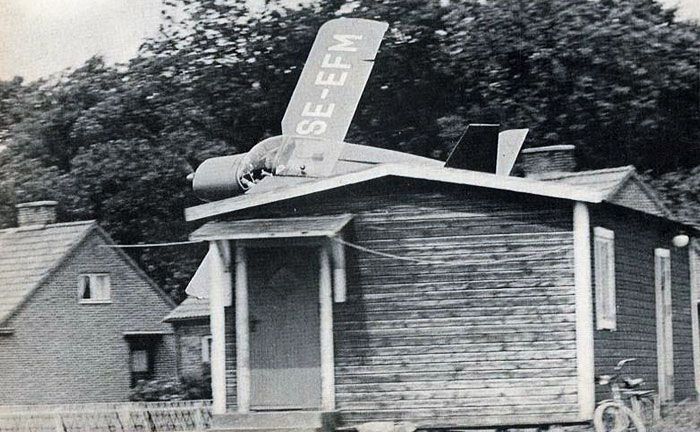 Saab test pilot Ove Dahlen flies a mini-counter-insurgency aircraft variant of a trainer, known as the Malmo MFI-9B, between houses in Sweden . The concept of a super-light, super-cheap attack aircraft with hard points for rockets was not well received and SE-EFM was eventually sold (as all other MFI-9B trainers were) as a civilian sport/general aviation aircraft, but for a while it was a bad-ass attack aircraft clearly capable of sneaking around buildings. Though SE-EFM and the purpose-built mini-COIN concept did not take hold, 5 airframes of the MFI-9B trainer, known as the Biafra Baby, were fitted with rockets and employed in the conflict in Biafra. Bombers do it. 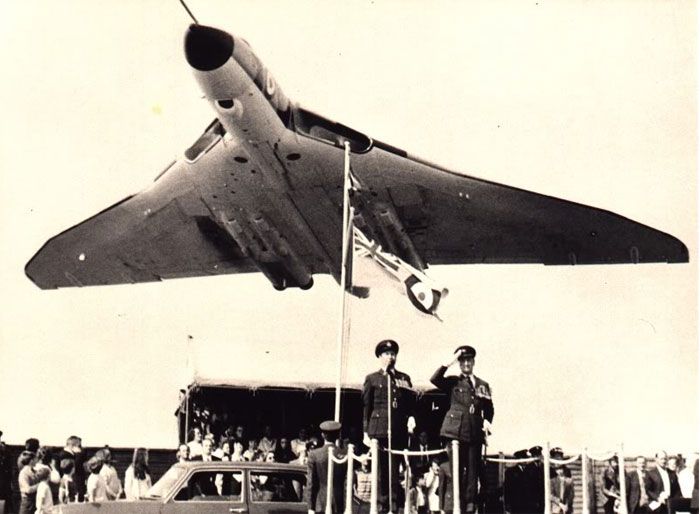 This is my favourite of all the low level shots, as the people (except the man on the left who is smartly covering his ears) have no idea how low this Avro Vulcan really is as it sneaks up behind them. The flag is at half staff, so this most likely was a sad occasio, but there were no doubt some shrieks and some olympic flinching when the sound reached them.  A British-based B-17 beats up a grass field 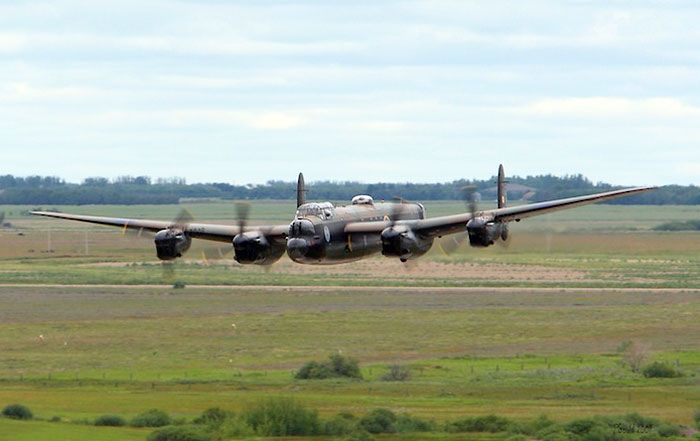 The Canadian Warplane Heritage Lancaster drops down to the infield of the Saskatoon airport. 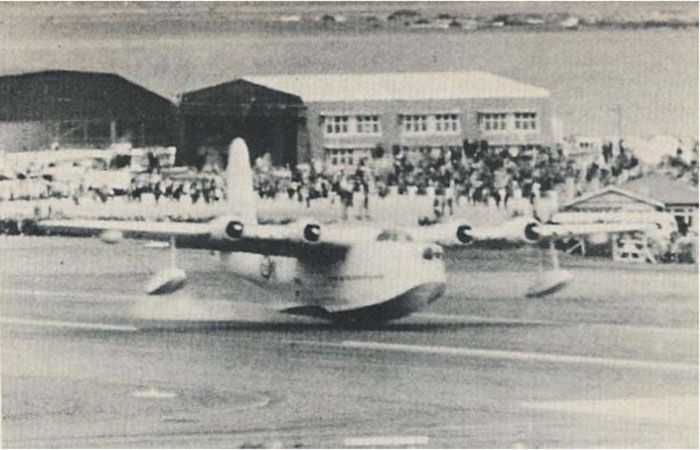 Royal New Zealand Air Force Short Sunderland doing a touch and go at Wellington airport in 1959 - Surely no-one can go lower than that! A touch an go in a wheel-less flying boat is not recommended. You couldn't get a damn slice of pastrami between the hull and the runway. There exists a crystal-clear shot in one of the RNZAF flight-safety publications that showed the aircraft just after it had done the "touch and go" clearly showing the bilge water escaping. Spectators were treated to a shower of dirty bilge water as it climbed away. Royal New Zealand Air Force Short Sunderland doing a touch and go at Wellington airport in 1959 - Surely no-one can go lower than that! A touch an go in a wheel-less flying boat is not recommended. You couldn't get a damn slice of pastrami between the hull and the runway. There exists a crystal-clear shot in one of the RNZAF flight-safety publications that showed the aircraft just after it had done the "touch and go" clearly showing the bilge water escaping. Spectators were treated to a shower of dirty bilge water as it climbed away. 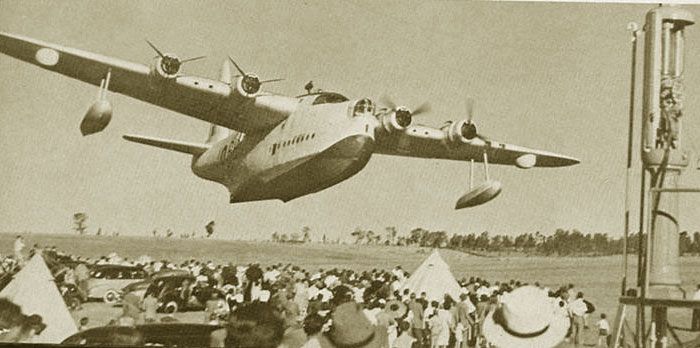 Another Sunderland being 'demonstrated' at Port Elizabeth , South Africa , may not be as low, but the pilot gets full degree of difficulty points for having two props feathered! 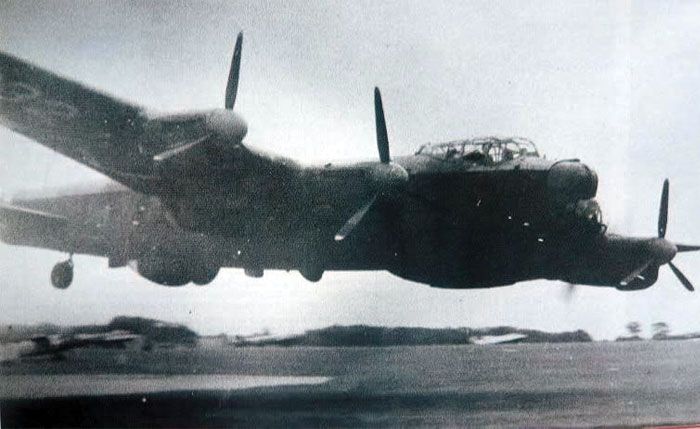 Thought two feathered engines on the same side was impressive for low level flight? How about three feathered and 20 feet below? This Avro Lancaster appears to be post war with the nose turret de-actvated and a dome in the dorsal position. This is a very foolish maneouvre.The aircraft can't be flown on a single engine. It's done by a dive, a high speed pass and a zoom climb at the far end of the runway with a mad scramble to unfeather. The situation gets serious if the first unfeathering knocks the generator on the good engine off line, leaving only battery power. Photo via Blake Reid Rhinos LOVE to do it.  An RAF Phantom II in full burner passes between two hangars at an RAF base. There isn't a Rhino-driver alive who didn't love dropping his locomotive-sized Phantom down to the hard deck and pushing the throttles right past the detents. 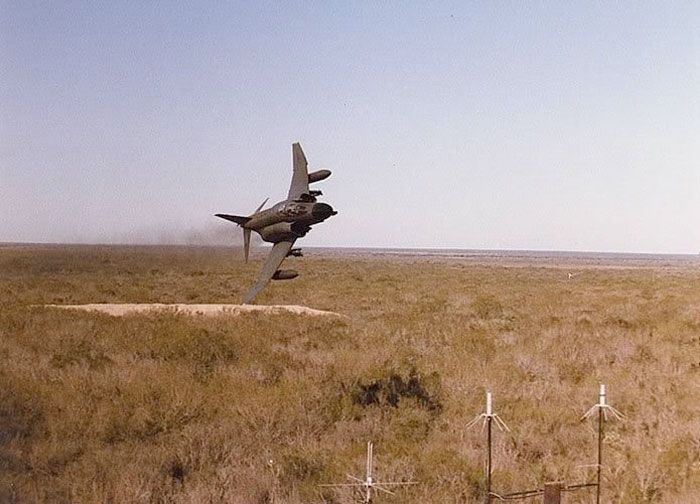 Like I said before, Phantom drivers love it down low 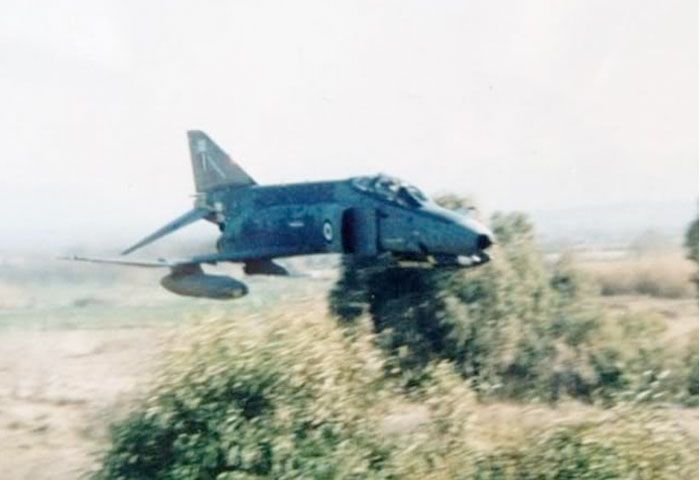 Flying even lower than the Greek economy is this GAF F-4 Phantom II picking its way through the bushes. 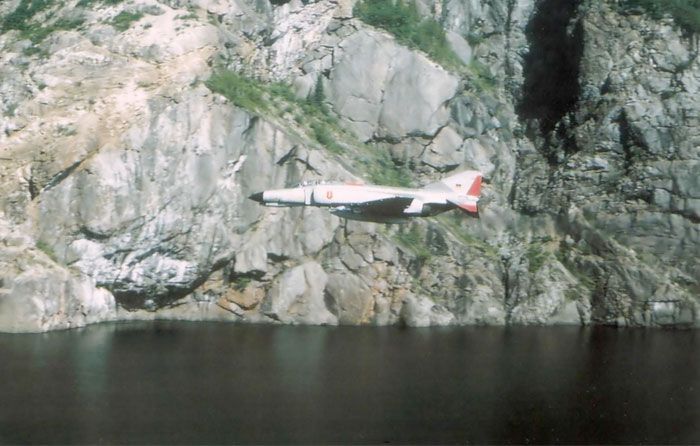 Down low, add in a little rock and some flat water and the fun escalates. Not sure what air force this one belongs to  A Panavia Tornado spews heat, gas, and vapour as she howls from the runway with her wingtip a few feet off the ground. 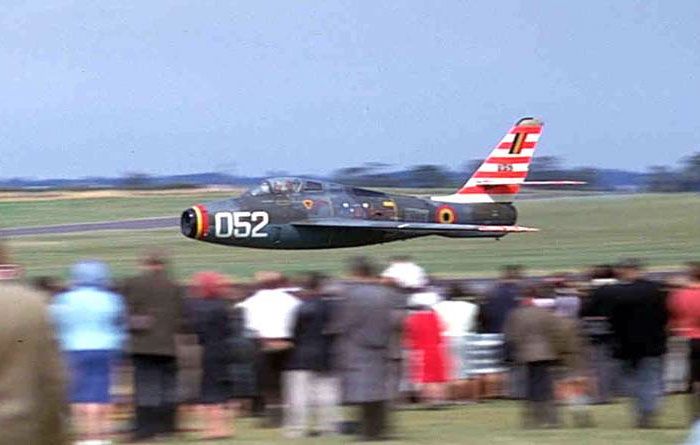 During an air show at RAF Wethersfield in 1964, a Belgian Air force pilot in a North American F-84 Thunderjet flies not only feet off the ground, but apparently just feet from the crowd. Times have changed. While perhaps not as exciting for the spectators, but certainly 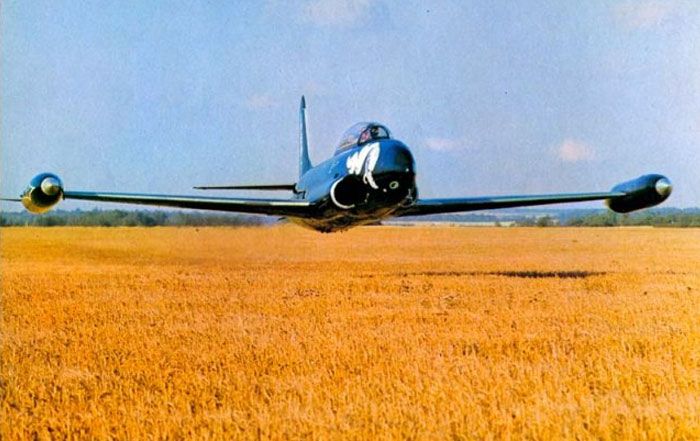 The legendary Ormand Haydon Balllie checks our wheat production at a farm outside of Duxford in 1974 in his T-33 (RCAF 21261) The Black Knight. Born in Devon , England during the Second World War, OHB moved to Canada in 1962, joining the RCAF. He would become a well known warbird collector and pilot after his service. 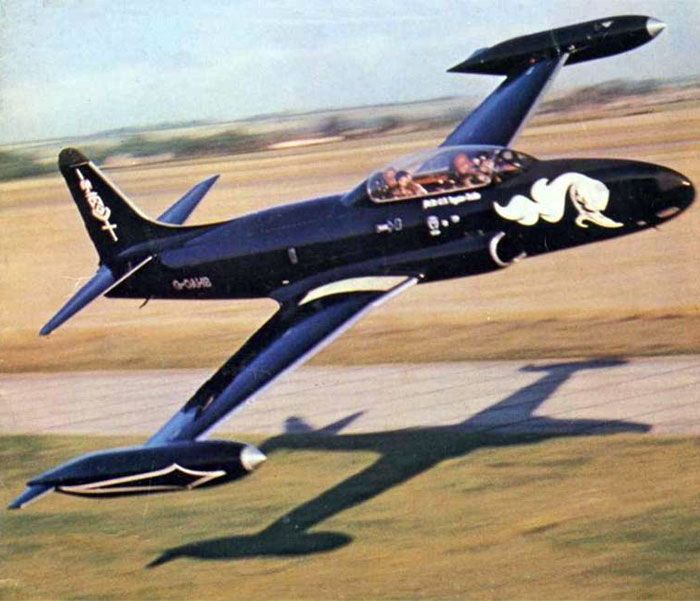 Another crazy low pass by Ormand Haydon Baillie in his Black Knight T-33 Silver Star.The spectacular paint scheme is based on an RCAF design for 414 Black Knight Squadron that flew the type. Vintage Wings of Canada is proud to have been part of 414's history. The squadron was disbanded in the 1990s. However, in December of 2007, approval was received for the squadron to stand up once more, this time as 414 EWS (Electronic Warfare Support) Squadron. Belonging to 3 Wing Bagotville, the squadron is based in Ottawa and is composed of military Electronic Warfare Officers who fulfill the combat support role, flying on civilian contracted aircraft. The squadron was re-formed at the Vintage Wings hangar at the Gatineau Airport on 20 January 2009 to operate the Dassault/Dornier Alpha Jet provided by Top Aces Consulting. Haydon-Baillie died in Germany in a P-51 Mustang on July 3, 1977. 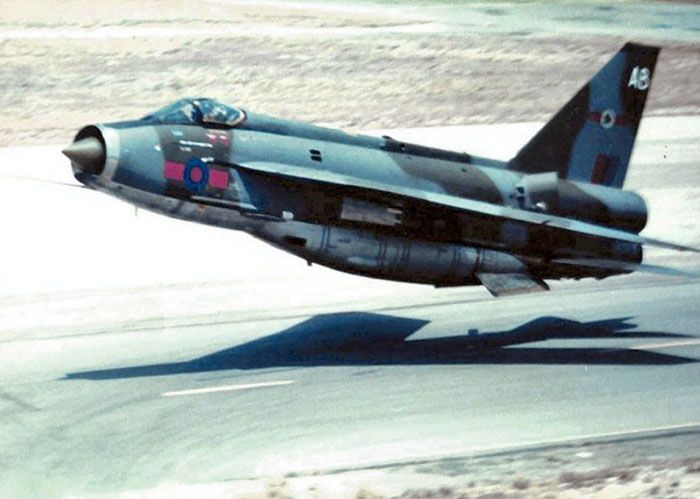 With speed brakes out, I am not sure whether this is a shot of a pass or a wheels-up landing for this British Electric Lightning 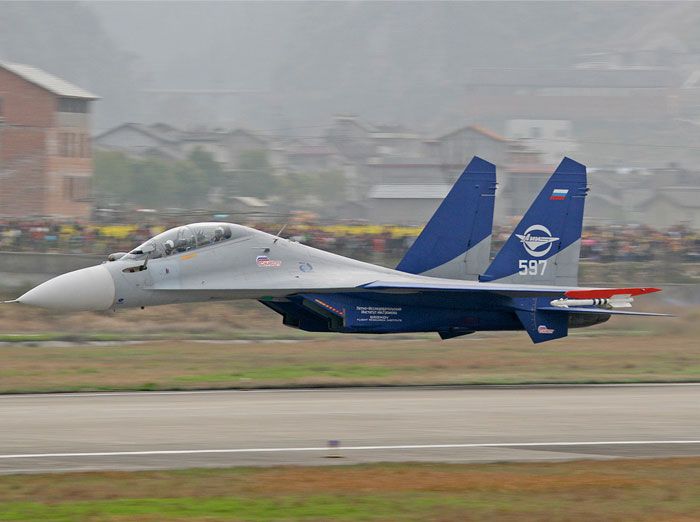 This Sukhoi Su-30 could be going Mach .98 or it could be hovering. Even airliners do it 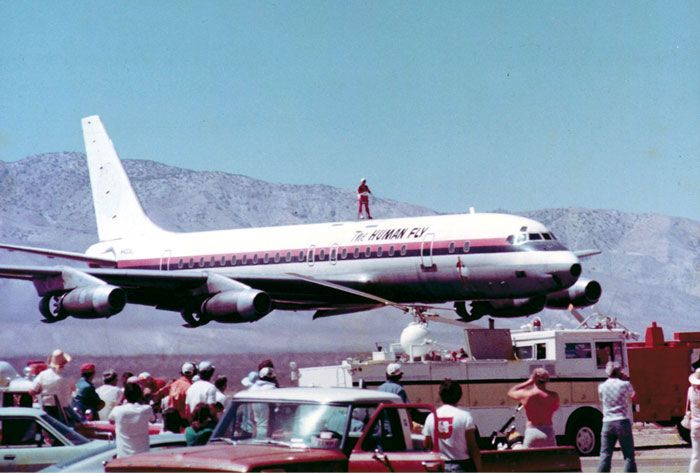 The Human Fly, a stunt man by the name of Rick Rojatt, makes a low pass on top of a DC-8 flown by the legendary Clay Lacy in front of the grandstands between events at the 1976 California National Air Races at Mojave. The aircraft is ex-Japan Airlines JA8002. It was owned and operated by American Jet Industries in 1976. 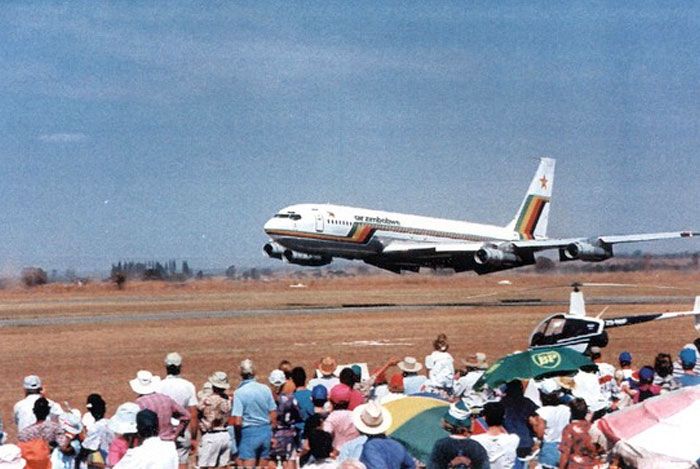 A Boeing 707 of Air Zimbabwe, flown by Darryl Tarr doing a low level, high speed flypast in Harare in 1995. According to witnesses, this was not the lowest the pilot flew. Tarr says that his radar altimeter read 6 feet beneath his keel at one time. Many believe that the flight was unauthorized and that Tarr was fired because of it, but he states that he made two flights) and they were both authorized. He recounts the facts of the flight in fine detail: 1. Three Crew members only on-board (Flight Engineer, First Officer, and myself) 2. Non- Revenue Flight (or non-commercial flight as some prefer) 3. 12,000 KGs of Fuel (2.0 hours endurance) 4. VREF Approach Speed Flaps 40 was 116 Knots (I was flying at 125 Knots) 5. Radio Altimeter call of 30 feet (from the FE), will be my cue to initiate a Go-Around 6. Back-up call from the F/O, plus visual cues (outside references due to the pitch attitude) 7. Rising ground and the fact that the aircraft is rotated towards +15 degrees in a Go-Around, the empennage will initially rotate downwards and get lower to the ground which was accounted for (as depicted in the photo, the aircraft is climbing) 8. High Speed Fly Past (which is not shown here), was at the Barbers Pole of 375 KIAS (due to the density altitude at Harare True Air Speed was 400 Kts) A beach makes a good open area to fly low in.  I can't even imagine how amazing it would have been to be on the beach this day to see a Consolidated B-36 “Peacemaker” fly down the line between water and sand. If he passed right overhead, both wingtips would be a spectacular 115 feet away in both directions. Designed for altitudes in excess of 35,000 feet, the Convair was a rare sight this close to the ground in level flight. 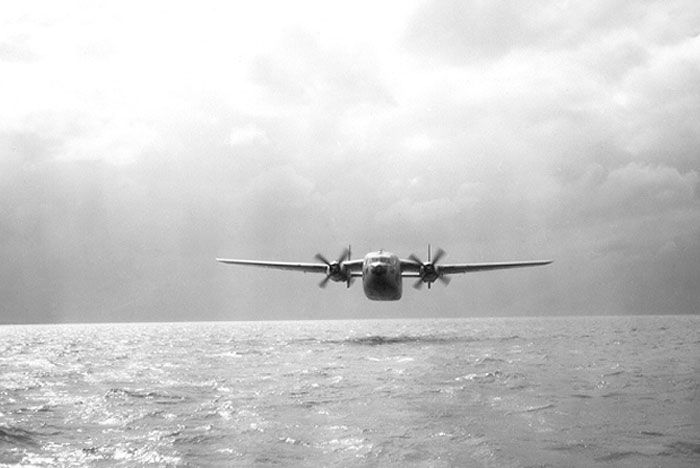 A spectacular shot of a Fairchild Provider flying low over sunlit waters... one of my favourite shots! via Blake Reid 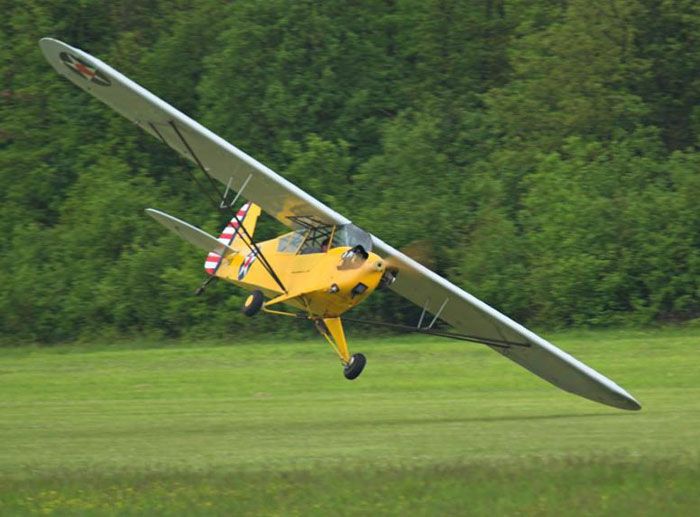 Sometimes, the difference between ground and aircraft is quite literally... inches. A Piper Cub comes as close as possible to a wing strike without damage. 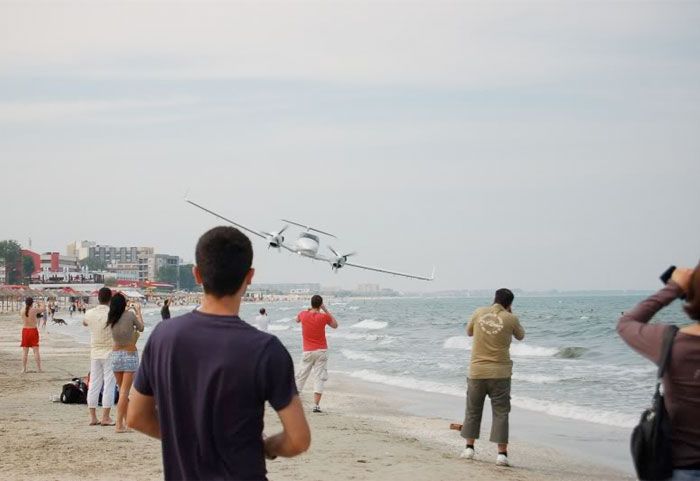 The twin-engined Diamond Star Twin rips along a beach. Judging by the number pf cameras at the ready, this was not an unauthorized fly by. The Navy loves to do it 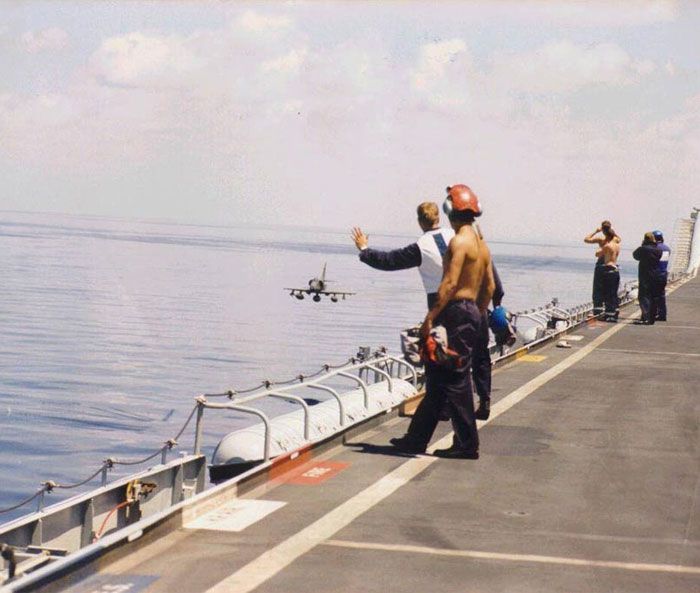 An Australian A-4 Skyhawk flies well below the deck of HMAS Melbourne . 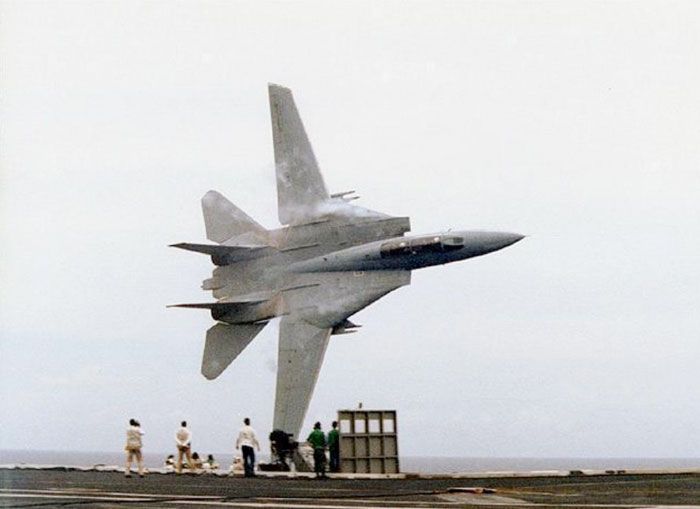 One of the most celebrated images of a low pass is this shot of F-14 Tomcat driver Captain Dale “Snort” Snodgrass making a curving pass alongside USS America. Many web-wags have stated that this was unauthorized, dangerous or that it even was a photo of a Tomcat about to crash. However, Snodgrass explained: "It's not risky at all with practice. It was my opening pass in a Tomcat tactical demonstration at sea. I started from the starboard rear quarter of the carrier, slightly below flight deck level. Airspeed was about 270 kts with the wings swept forward. I selected afterburner at about a half-mile out, and the aircraft accelerated to about 315 kts. As I approached the fantail, I rolled into an 85-degree bank and did a hard 5-6G turn, finishing about 10-20 degrees off of the boat's axis. Microseconds after this photo was taken, after rolling wings-level at an altitude slightly above the flight deck, I pulled vertical with a quarter-roll to the left, ending with an Immelman roll-out 90 degrees and continued with the remainder of the demo. It was a dramatic and, in my opinion, a very cool way to start a carrier demo as first performed by a great fighter pilot, Ed "Hunack" Andrews, who commanded VF-84 in 1980-1988. 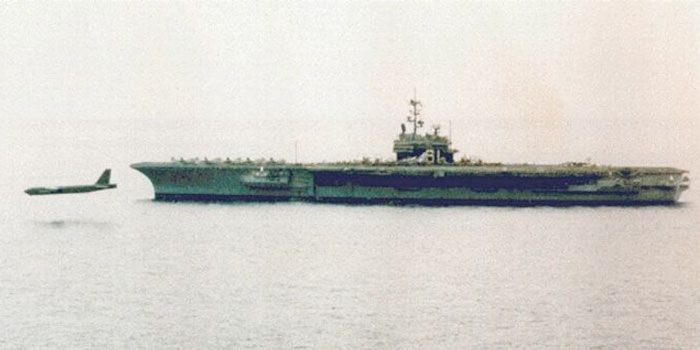 A B-52 slides down the port side of USS Ranger (CV-61) in its typical nose down cruise attitude. Though it looks like it, this is not photoshopped. It happened in early 1990 in the Persian Gulf, while U.S. carriers and B-52s were holding joint exercises. Two B-52s called the carrier Ranger and asked if they could do a fly-by, and the carrier air controller said yes. When the B-52s reported they were 9 kilometers out, the carrier controller said he didn't see them. The B-52s told the carrier folks to look down. The paint job on the B-52 made it hard to see from above, but as it got closer, the sailors could make it out, and the water the B-52's engines were causing to spray out. It's very, very rare for a USAF aircraft to do a fly-by below the flight deck of a carrier. But B-52s had been practicing low level flights for years, to penetrate under Soviet radar. In this case, the B-52 pilots asked the carrier controller if they would like the bombers to come around again. The carrier guys said yes, and a lot more sailors had their cameras out this time. Photo was taken from the plane guard helicopter 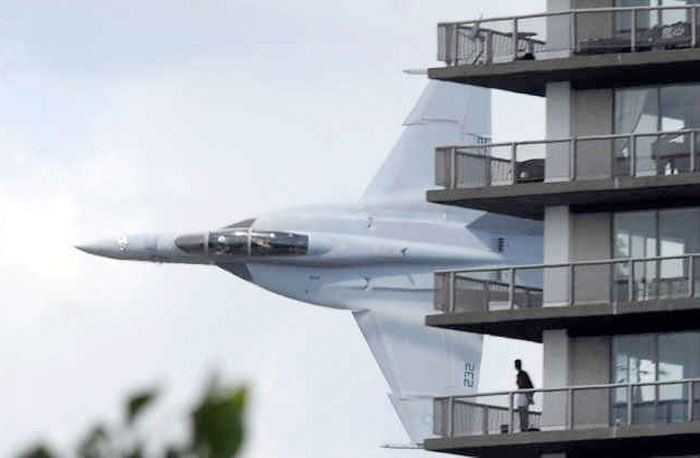 In 2009, a Navy F/A-18F Super Hornet crew got permission for a low-level demonstration flight as part of the opening ceremony for a speedboat race on the Detroit River , This is what it looked like for Motor City residents. Officials waived rules to allow the Navy flyers to swoop under 100ft along the waterway. One resident said, "I couldn't believe how low they flew and how close they came to our building. I'm sure the pilot waved at me." Photo: AP/The Detroit News, Steve Perez. Originally spotted at theDaily Mail. 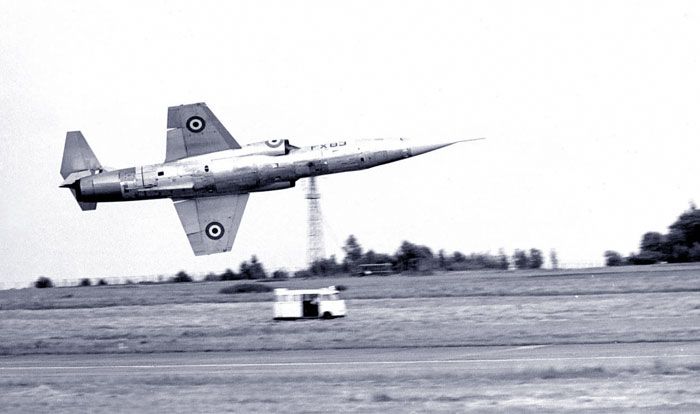 A Greek F-104 turns out after a high speed low level pass.  The Spitfre MK923, belonging to Hollywood actor Cliff Robertson of Baa Baa Black Sheep fame, and flown by Jerry Billing, does a extreme low pass over a grass strip at his home in Essex County, Ontario. From 1975 through 1994 the Billing air strip was a prime spot to see Jerry practice in MK923. People would line the 5th Concession Road to watch Jerry wring out the Spit. Cliff Robertson, famed for playing JFK in PT 109, died in September of 2011. Photo via Bob Swad 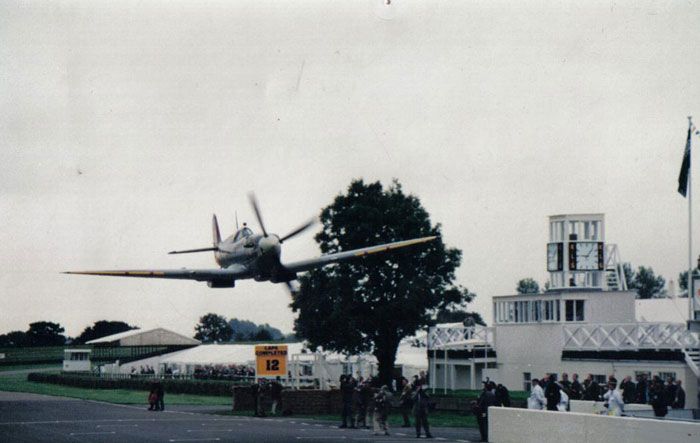 The legendary, extraordinary Ray Hanna makes an extreme low level pass in a Spitfire down pit lane at the Goodwood auto racing track in England in 1998. Sadly, with the death of Hanna, we will not see such feats again. Enough said! Let the RAAF show you how it's done! | ||
|
| One of Us |
Back in the late 60's and early 70's, one of my squadron's training exercises was to fly "oil burner" sorties. The routes were published and you could find one from about any fighter base to another, some 500 miles or more, so, on a weekend, you might fly one from MCAS Beaufort, SC to NAS Memphis, grab a snack for lunch, then fly another to Tinker AFB and spend the night (cowboy music, club open to non-military women and the world famous Tinker Burgers.... and I crashed a TA-4J there once?) On Saturday, you'd fly to, maybe, Nellis (you could get really low over the desert) and then to NAS Miramar for happy hour (before Tom Cruise got out of diapers). Sunday, since you were flying back East and lost three hours, you'd usually just practice high-altitude IFR cross-country navigation with one stop on the way back so the plane could be prepared for the regular flight schedule on Monday morning. If I remember correctly, minimum height was supposed to be 500' and 500 kts, but, since the purpose was practicing for a below radar incursion into enemy airspace, we flew them at 50 feet (or as low as we felt comfortable as our experience grew). At the end of the route, there was always a bridge or some other "target" upon which you did either an idiot loop or a pop-up attack. Fun! In the five years I flew them, interrupted by S.E.A. flying, I never heard of any tight ass raising hell about our flights, even though we certainly flew over populated areas (albeit small towns and farms). BTW, at 500 kts. and at 50', you don't have to worry about buzzards. They are above you (at least most of the time). And, they paid me for that!!!! JudgeG ... just counting time 'til I am again finding balm in Gilead chilled out somewhere in the Selous. | |||
|
| one of us |
Judge: I'd love to have lived a few hours of your life! There is hope, even when your brain tells you there isn’t. – John Green, author | |||
|
| One of Us |
I was home based at NAS Lemoore, CA early to late 70s. We had one low level route that started on the northern coast of CA and then up into Oregon and south to the Navy Fallon weapon complex to make a drop. One section of that route was along a nice straight highway for a long segment. At 500 kts and 50', or usually below, the telephone poles look like a picket fence. Semi truck brakes make the biggest, neatest cloud of white smoke when they perceive a headon with an A-7 flying at 25'. | |||
|
| One of Us |
Thanks for the great pictures.Reminds me of the old days when I was waterbombing with the PBY. Below 100 ft.all summerlong,we wanted oxygen if we ever got up to 500 ft.I remember one fire in northern Manitoba was right on a B52 low level practice route and I had Buffs low overhead as I picked up water and made my bomb runs.I loved that job did 5000+ bomb runs,great fun. Bill DRSS | |||
|
| one of us |
Yea when I learned to fly the called them Oil burner Routes and they charted them on VFR charts. Then some time around 1978 or so the changed the Name to Olive Branch Routes. I guess Oil Burner was not PC enough. The still fly those routes. Common sense tells you, you put a jet or a turbo prop airplane down on the deck, below 500 Agl and yea you are going to burn Jet A and a good clip. I once saw 18 C-130's barreling down a route in west texas at about sun set. You could smell the Jet A and the noise. Freedom!!! | |||
|
| One of Us |
Great photos! Here's a short video showing a Master of Low Flying: http://www.youtube.com/watch?v=M2CBx7x5GCI The quality of the video isn't as good as it could be, but it shows the pilot picking up a piece of cloth with his wing tip. As for the loop on the dead prop before landing, I'm guessing the altitude is less than 500 feet. "The appearance of the law most be upheld--especially while it's being broken." Boss Tweed | |||
|
| One of Us |
Here's one more short clip of Udet's low altitude flying with his Flamingo biplane: http://www.youtube.com/watch?v=pwAZq1nVlZA An amazing man literally addicted to flying, but it led to a pact with evil that destroyed him. "The appearance of the law most be upheld--especially while it's being broken." Boss Tweed | |||
|
| Powered by Social Strata |
| Please Wait. Your request is being processed... |
|
 The Accurate Reloading Forums
The Accurate Reloading Forums  THE ACCURATE RELOADING.COM FORUMS
THE ACCURATE RELOADING.COM FORUMS  Other Topics
Other Topics  Aviation
Aviation  A Celebration of Low Flying
A Celebration of Low Flying

Visit our on-line store for AR Memorabilia

